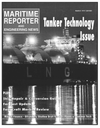
Page 43: of Maritime Reporter Magazine (March 1997)
Read this page in Pdf, Flash or Html5 edition of March 1997 Maritime Reporter Magazine
PROPULSION UPDATE
Folk Drives For
Efficient Maneuvering
Medium and high-speed diesel engines with narrow operating speed ranges can result in vessel speeds that are too high at engine idle. To reduce ship speed, such as when docking or handling fishing nets, opera- tors are forced to continually shift from ahead to neutral, or ahead to astern, resulting in potentially inefficient methods of speed control.
Figure 3 — Reduction drive shown "unfolded." Pinions A and B both engage low- speed (propeller-shaft) gear at all times, but only one transmits torque at any time.
Figure 4 — Crash reversal maneuver at 900 rpm on a tuna seiner, with engine torque-up system.
Continuous-slip drives and torque-application controls fix that and enhance the operating speed range of modern propulsion sys- tems.
The case for this solution is presented in this paper by Timothy
Vail, project engineer, Marine Engineering Group, The Falk
Corp. By controlling the hydraulic pressure on the ahead or astern clutch, a continuous-slip control marine drive system pro- vides closed loop speed control which increases the propeller shaft speed range from engine idle (Continued on next page)
Australian Mooring
Specialist Wins Contracts
Melbourne, Australia-based mooring specialist Harbour and Marine Engineering Ptd.
Ltd. was recently awarded a contract to supply an integrat- ed jetty monitoring package for a new LPG berth being con- structed for the Port of Bintulu in Sarawak, East Malaysia.
The equipment will include quick release mooring hooks, an emergency remote release system, vessel load monitoring and a laser docking system.
The company has also won an order to manufacture ten 650T safe working load capacity chain stoppers for 100-mm diameter stud link chain. The units will reportedly be installed on Tanker Pacific's
FSO vessel Deep Blue.
For more information
Circle 90 on Reader Service Card
Circle 315 on Reader Service Card
March, 1997 51
ENGINE SPEED INCREASES
WHILE UNDER INCREASING
LOAD DUE TO ASTERN
CLUTCH ENGAGING WHILE
THE SHAFT BRAKE IS ON ••/'
ENGINE SPEED (RPM>
PROPELLER SPEED (RPM>
ASTERN CLUTCH PRESSURE
SHAFT BRAKE PNEUMATIC SIGNAL
AS SHAFT BRAKE IS RELEASED.
THE PROPELLER SHAFT ACCELERATES
UNTIL CLUTCH LOCK-UP IS ACHIEVED 700.0 650.0 600.0 550.0 500.0 450.0 400.0 350.0 300.0 250.0 £00.0 150.0 100.0 50.0 • 0.0- -50.0 -100.0 -150.0 -200.0 -250.0
ENGINE SPEED DECREASES AS
SHAFT BRAKE IS RELEASED
AND PROPELLER SHAFT LOAD
IS APPLIED..
ENGINE SPEED FALLS UNTIL JUST - ABOVE ENGINE IDLE SPEED, AT WHICH , POINT ASTERN CLUTCH LOCK-UP OCCURS •pre FAIJC CORPORATION
MARINE ENGINEERING GROUP
TIMOTHY VAIL 20 TIME (Seconds) 900 RPM CRASH REVERSAL UTHJZINO
THE FALK ENGINE TORQUE-UP SYSTEM
CLUTCH
TRANSFER GEARS
PINION A
LOW SPEED
PINION B
INTERNAL
HYDRAULIC
SHAFT
BRAKE
Producing Thrust
SCHOTTEL means CONFIDENCE.
We develop, design and manufacture steerable propulsion and manoeuvring systems with power ratings up to 6000 kW. ABS, BV, DNV and GL have certified our Quality Management
System according to DIN EN ISO 9001.
Your main benefits using SCHOTTEL products: • High performance • High reliability • High efficiency • High quality (and naturally a 24-month warranty) • High durability
Your main benefits joining SCHOTTEL engineers: • Tailored system engineering • Project and installation assistance • Professional service worldwide
For planning newbuildings or conversions we are the right partners, join us.
SCHOTTEL-North America, Inc. 1505 Corbin Avenue, Hammond, LA 70403
Tel: (504) 5427174 • Fax: (504) 5425347
Headquarters:
SCHOTTEL-Werft Josef Becker GmbH & Co. KG
Mainzer Strasse 99, D-56322 Spay, Germany
Tel:+ 49 - 26 28 - 6 10 Fax:+ 49-26 28 - 6 1300 ^CHOTTEL

 42
42

 44
44
